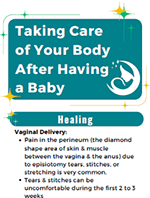I Want to Learn About Taking Care of My Body After Having My Baby
Just as your body changes over time to grow and birth a baby, it takes time and care for your body to recover. Your recovery may be different based on how your baby was delivered. It takes longer to recover from a cesarean section than a vaginal delivery. Many people also need emotional support during this process.
It is common to feel tired and to have some discomfort after giving birth. You may experience pain in your perineum, which is the area between your vaginal opening and your anus. You may also experience uterine contractions. Use the guide below to help you know the difference between normal symptoms and when to seek medical care.
-
Healing
To allow your body to heal after birth, do not place anything in your vagina (such as tampons) or have sex for a few weeks. Give your body time to heal before doing any demanding activity including exercise.
Vaginal Delivery
- Pain in the perineum (the diamond shaped area of skin and muscle between the vagina and the anus) due to episiotomy, tears, stitches, or stretching is very common.
- In the case of an assisted delivery (forceps or vacuum) tears and stitches can be very uncomfortable during the first 1-2 weeks.
Cesarean Section
- A cesarean section, or C-section, is major surgery and it will take time to recover. Some women require no pain medicine within a few days to weeks and others may require 2-3 months to feel normal. The operation itself becomes more complicated if you have had more than one.
- Infection and poor wound healing can occur with C-sections. Contact your provider right away if you experience any of these symptoms.
-
Checking In With Your Provider
Your health care provider will usually have you schedule a visit 4 to 6 weeks after giving birth. This is called a postpartum visit. In many cases this visit is too late to address health concerns that may occur suddenly. Instead of waiting, try to have contact with your health care provider or nurse within the first 3 weeks after you give birth.
Things to discuss (phone or in person) may include:
- Breastfeeding or pain or swelling in your breasts (mastitis)
- Vaginal bleeding
- Perineal or incisional pain
- Swollen, red or painful legs
- Headaches with or without vision changes
- Not being able to hold your urine (incontinence)
-
Common Post-Partum Complications
After childbirth, you’re likely focused on caring for your baby, and most people who give birth recover without problems. But serious health problems can happen in the weeks to months after giving birth. Contact your provider if you are not feeling well or have questions or concerns about any symptoms you experience.
Learn these post birth warning signs AWHONN.

"Taking Care of Your Body After Having a Baby" by Mecklenburg Birthing Connections (pdf)
Download Now
